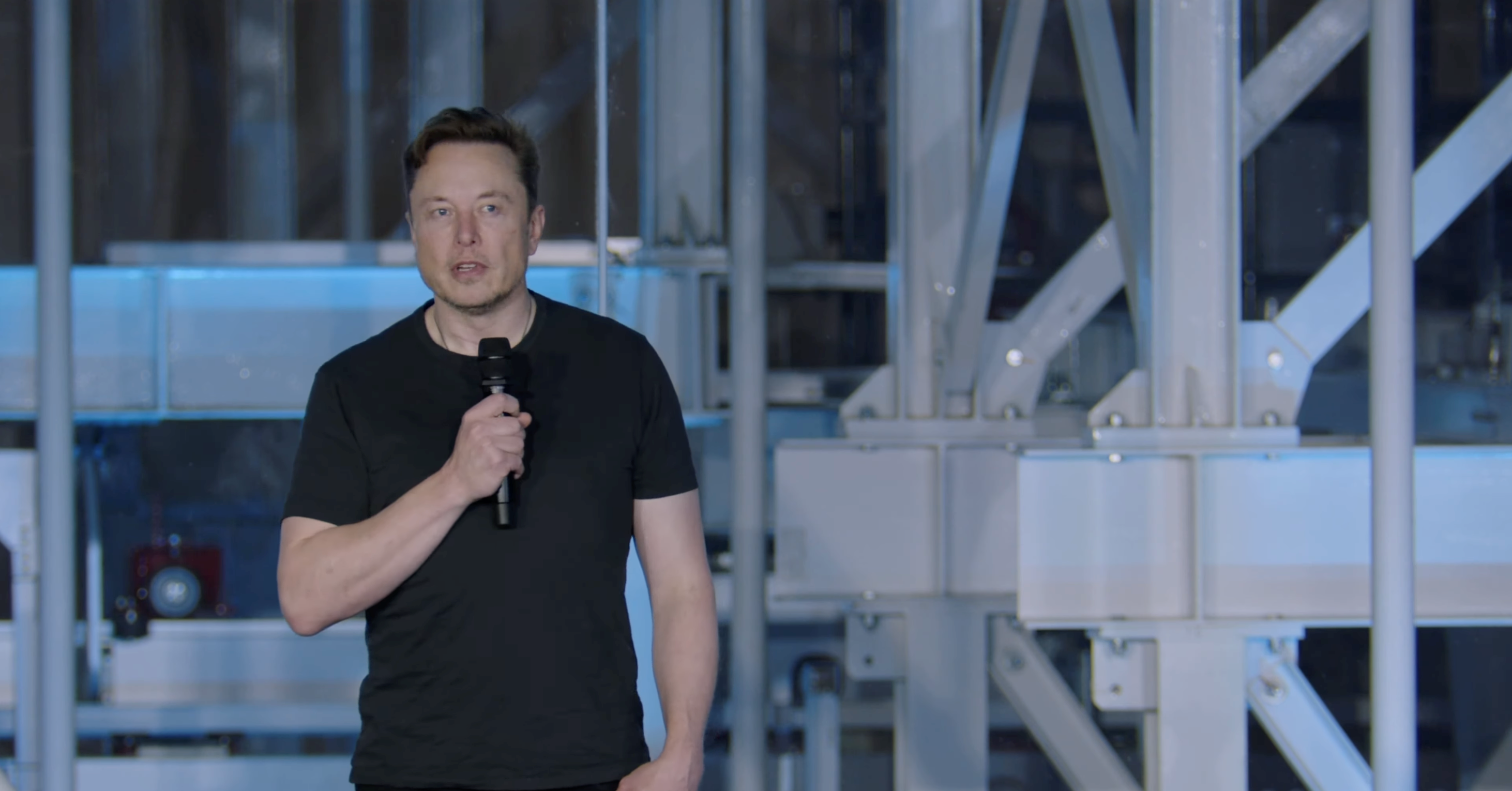Authors: Zhu Shiyun, Wang Lingfang
Editor: Qiu Kaijun
Can the money-making giant machine recreate a miracle?
After the U.S. stock market closed on March 1st EDT, Musk released “Master Plan Part 3”. The next day, Tesla’s stock price opened a more than 8% drop and closed at $197 per share on Friday, a 3% drop from March 1st.
Investors are not to blame for their fear.
Completing “Master Plan 3” – the global comprehensive shift to sustainable energy, aiming to achieve 100% sustainable energy by 2050 – requires $10 trillion in construction investment.
Is Musk serious? This is 10% of the global GDP in 2022. Can one person or one company carry such a task?
We should have dreams, what if it comes true? Let’s help Tesla calculate seriously:
Based on the capital expenditure of $15 billion per year for 2020-2021 for Tesla’s construction of the Texas and Berlin factories, and the heavy reinvestment in the development of 4680 and D1 chips, Tesla will need 666 years to independently complete “Master Plan 3”, while its actual plan is only 27 years.
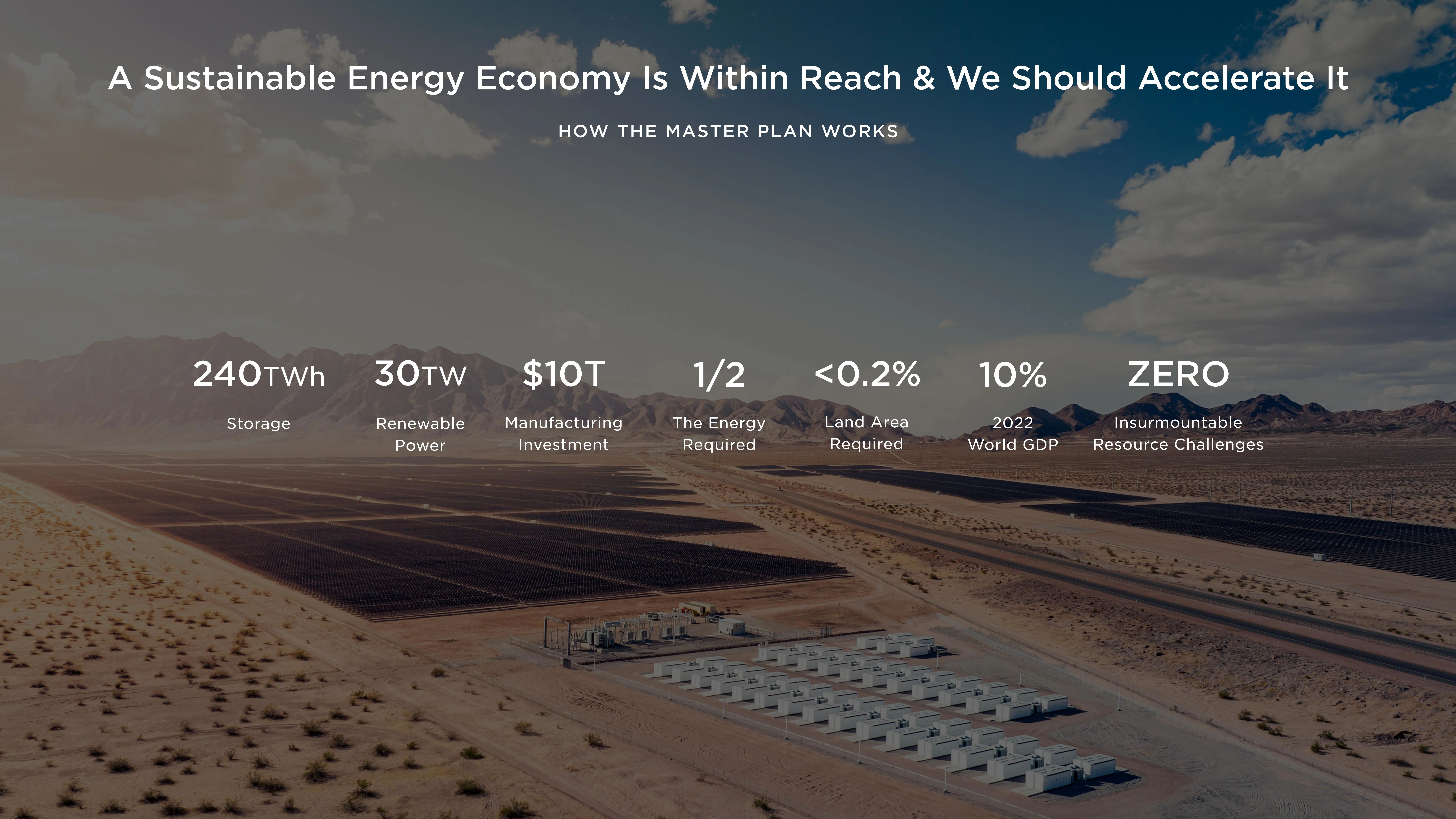
But if Tesla can achieve 30% annual compound growth based on $15 billion, it can complete the investment of $10 trillion after 20 years. Moreover, the time span can be extended to 2050, and Musk’s previous annual growth target for Tesla was 50%.
In this way, Tesla still has the opportunity to turn impossible into possible. The only question is, how to achieve continuous high growth? This investor day did not provide many details. However, “Electric Vehicle Observer” analyzed Tesla’s business progress comprehensively, trying to answer: Where will Tesla earn $10 trillion?## Tesla’s Serious Investment of Trillions of Dollars
The investment of trillions of dollars is a significant amount of money.
By 2050, investing in the construction of wind and solar power generation and energy storage facilities on the global land area of less than 2‰, which equates to 10% of the global GDP in 2022, and combining with Tesla’s fleet of 1.44 billion electric vehicles, will result in 240TWh of energy storage resource and 30TW of renewable energy.
At that time, not only cars, but also ships, airplanes, and buildings will use clean energy from wind and solar power. This will ultimately achieve a completely sustainable energy economy, which is Musk’s “Master Plan, Part 3.”
The key point is that “trillions of dollars” and a “completely sustainable energy economy” are not a “Tower of Babel” built by Tesla and all of humanity together, but a grand plan that Musk intends to accomplish single-handedly.

In Musk’s plan, $0.9 trillion, $7 trillion, $0.3 trillion, $0.8 trillion, and $1 trillion will be invested respectively in renewable energy, automotive, building area, thermal and hydrogen energy, ships, and aircraft. By means of clean energy grids, mobile transportation electrification, and heat pumps into households, 35%, 21%, 22%, 17%, and 5% of fossil energy use will be replaced, ultimately achieving a 100% sustainable energy economy.
The electric vehicle investment, which dominates the absolute majority, will be entirely used to build Tesla’s fleet of 1.44 billion electric vehicles. In addition, Tesla’s independent research, production, and construction of heat pumps and energy storage battery factories further confirms that this $trillions “grand plan” will be completed by Tesla itself.
Is it possible?
Selling 700 Million Units of the “$15,000 Model 2/Q”
Economic cars will be the core part of Tesla’s energy transformation plan.

According to the plan, the investment in the automobile business accounts for 70% of the $trillions, which currently focuses on eight models, among which “the next-generation model” is the core with a proportion of 48.6% to sell 700 million units, equivalent to the proportion of economical passenger cars in the overall automobile market.“`
According to the data from China Passenger Car Association, 45% of the on-insurance cars in the 10-20 million yuan price range in 2021 are in China.
Can Tesla, which is still positioning itself as a luxury brand, enter the price range of economic models with its “next generation vehicle”? According to the information disclosed so far, it seems possible.
Information from Investor Day showed that the 5-year ownership cost of the “next generation vehicle” is about 71% of the Model 3.
Tesla’s data for 2021 shows that the ownership cost of a Model 3 for 5 years and 60,000 miles is 63 cents per mile, while the “next generation vehicle” is 44.7 cents per mile, totaling 26,800 dollars. If the standard deduction of $2,000 for electricity and $800 for tires is applied as for Model 3, the purchase price for users may be $24,000.
The price of $24,000 to $26,000 is very consistent with Elon Musk’s previously announced “cheap car” Tesla Model 2 for $25,000 and also enters the core price range of 150,000 yuan for economic passenger cars. Tesla also uses the world’s best-selling car model in this price range for comparison – the Toyota Corolla, with a cumulative global sales of 50 million units since its launch 56 years ago.
Clearly, even with the economic model, achieving sales of 700 million units is still a huge challenge.
“Model 2/Q” reduces costs and maintains performance
Unlike the Toyota Corolla, Tesla will create a greater profit margin for the next generation vehicle.
According to the information disclosed on Investor Day, the cost of the next-generation vehicle will be reduced by 50% compared with Model 3/Y by innovation and scale. In Q4 2022, Tesla’s automotive business gross margin was 25.9%, which means Model 2/Q’s cost is about $13,000, with a profit margin of up to 48%.
As we all know, the high profit margin of bicycles is the basis for Tesla's price war. The question is, can such low cost guarantee performance?
**Model 2/Q will adopt a $1,000 electric motor, a 48V low-voltage platform, a lithium-ion battery, and a heat pump system.**
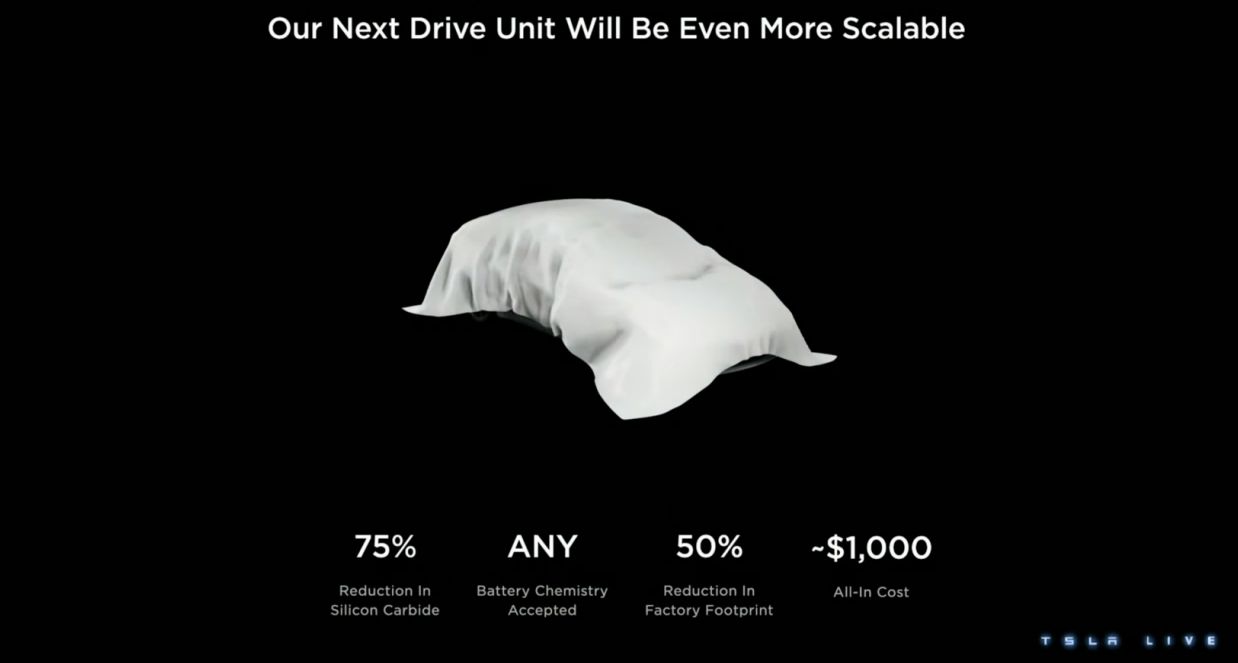
**The cost reduction of the motor is mainly achieved by reducing the usage of SiC components by 75\%.**
SiC is used as a power component in electric vehicles, with high voltage resistance, low switching loss, and high efficiency advantages.
However, due to the slow growth rate of the crystal rod, SiC mass production is still hindered. Compared with the growth rate of 30-150mm/h of general silicon crystals, SiC crystal rods are only 0.2-0.4mm/h, which is hundreds of times lower. The SiC substrate technology barrier is also very high, resulting in high SiC prices and low production.
There are several guesses in the industry regarding Tesla's reduction of SiC usage:
**First, Tesla wants to abandon silicon carbide and choose gallium nitride (GaN) with lower power loss (higher efficiency).** But currently, GaN has not yet reached the requirement for mass production, and the yield rate of the chips made from gallium nitride substrates sold in the market is only 33\%, with low quality rates, which leads to high cost. Moreover, the application of GaN does not correspond to the idea of Tesla reducing SiC usage, so it is less likely to happen.
**Second, Tesla wants to use back Si-based IGBT.** However, there are still many problems to be solved in the packaging and sintering process of this solution, and there is currently no definite information indicating that Tesla or its chip suppliers can achieve this.
**The most likely solution is to reduce the usage of SiC components in the next generation of main drive inverters.**
Tesla Model 3 uses 24 power single tubes, and each single tube uses 2 SiC components, totaling 48 components. If the usage is reduced by 75\%, it means 12 components.
During the investor day, they mentioned that they will use "customized module packaging technology." Compared with the SiC power module products on the market, the heat dissipation of this packaging technology has been improved by about twice. This means that the SiC chips in the module packaging will be much smaller.
Speculating reasonably, Tesla may be trying to reduce the size and amount of SiC devices through the improvement of power module technology.
Of course, another auxiliary is the shift to the 800V architecture. The upgrade of the voltage platform can also reduce the usage of SiC. By the iterative improvement of these two technologies, it is possible to reduce the number of SiC devices.
Compared to cost reduction, the non-rare earth permanent magnet drive motor may have more geopolitical influence.
The permanent magnet made of rare earth materials is generally the preferred choice for permanent magnet motors due to its superior and stable performance. However, there are also some motors that do not use rare earth, such as BMW’s production of excited motors, Mahle’s magnet-free motors, and so on.
According to the “Electric Vehicle Observer,” when communicating with a senior expert in the motor field, it was learned that the most typical motor that does not use rare earth permanent magnet materials is the ferrite motor, and General Electric in the United States had produced this product long before. However, to achieve the same power, the volume and mass of the ferrite are much larger, which means that the amount of copper and iron materials used in the ferrite motor is much more than that of the rare earth permanent magnet motor, so it is difficult to say which one is more cost-effective. “For a period of time, whether to use ferrite motor or light rare earth motor for air conditioning depends on the price, whichever is cheaper,” the expert said.
Of course, under the same volume and weight, the motor with rare earth still has the maximum power and the highest efficiency, which is undoubtedly true.
That is to say, the non-rare earth motor has a short high-efficiency interval and a large volume and weight. When the two are superimposed, the average power consumption of non-rare earth motor vehicles will be much higher than that of rare earth motor vehicles.
The 48V low-voltage platform also has a cost-reducing effect.
Tesla stated that starting with the Cybertruck, Tesla will gradually shift to the 48V platform. Compared with the 12V low-voltage platform, the increase in voltage of 48V can reduce the heat generated by the wire harness by reducing the current, and more slender or other materials can be used for the wire harness, which can reduce weight and cost.
However, switching to 48V means that the internal power supply isolation must be stricter, and the design of controllers and power supply systems that can support 48V will have a significant impact on circuit design, supplier supply, change management, and so on.
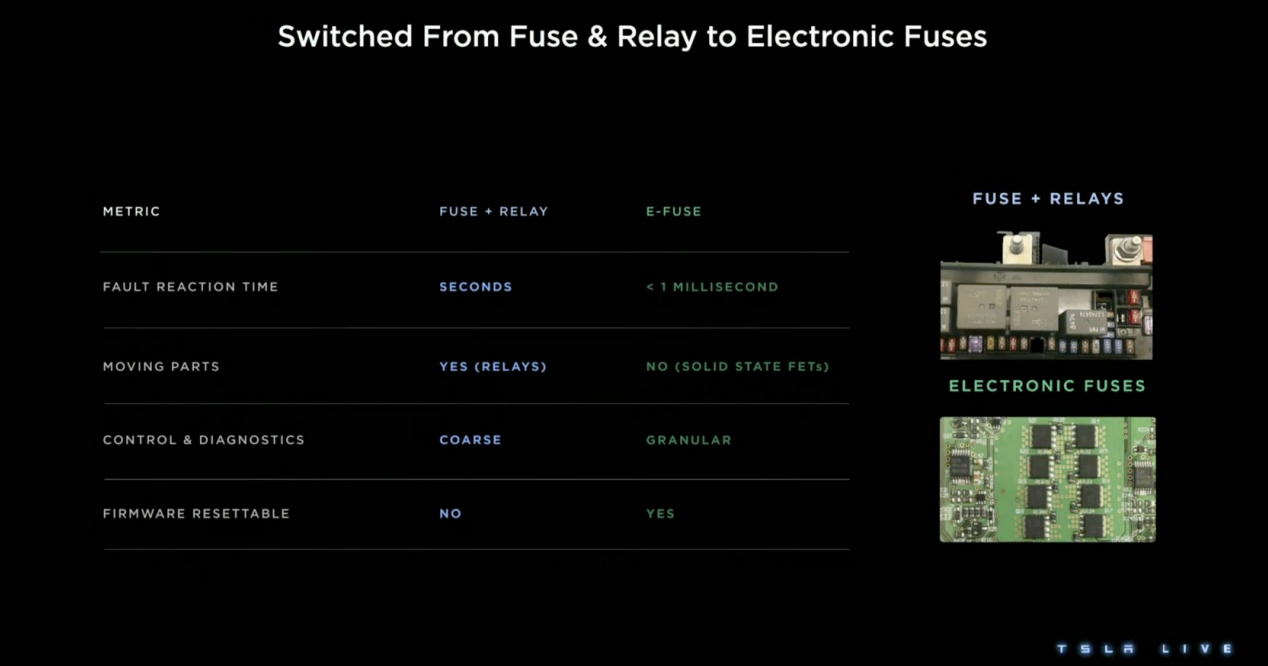
“““
Note that Tesla has designed its own “electronic fuse” which integrates the functions of a fuse and a relay, with a response time of milliseconds and the ability to support firmware resets through OTA.
Therefore, while switching to 48V may reduce the cost of vehicle-side, the cost of system modification should not be underestimated, and with the realistic constraints of silicon carbide and rare-earth-free motors, it remains questionable whether the Model 2, even after a 50\% cost reduction, can be as good as the Model 3.
Producing 1.4 billion cars in 27 years
During the Q&A session of Investor Day, Musk requested to skip the question about Model 2/Q. In fact, new production capacity is probably a more urgent and difficult task for Tesla’s 20-year high-growth goal than new cars.
As of the day of Investor Day, Tesla had produced and delivered a cumulative total of 4 million cars, completing the transformation from 0 to 1 as an automobile company, but only a small portion of the goal of producing 1.4 billion cars has been completed.
The question is, where to produce the remaining 1.4 billion cars? Currently, the official announced production capacity of Tesla’s factories in Shanghai, the United States, and Germany is 2 million cars. As Zhu Xiaotong, editor of Teslas, said, “The passing line for Tesla production plant is 90% overall equipment efficiency and one car produced every 45 seconds.”
On the passing line, investors estimate that the annual production capacity of the above three factories can reach 3.2 million cars (Shanghai factory 1.2 million cars), but “what about the future production capacity? The construction cycle and production ramp-up of factories in Texas and Berlin are so difficult, and who knows when the factory in Mexico will be ready. Shanghai is the most suitable, it is a pity.”
With site selection being an issue, Tesla is further improving the production efficiency of its existing factories.
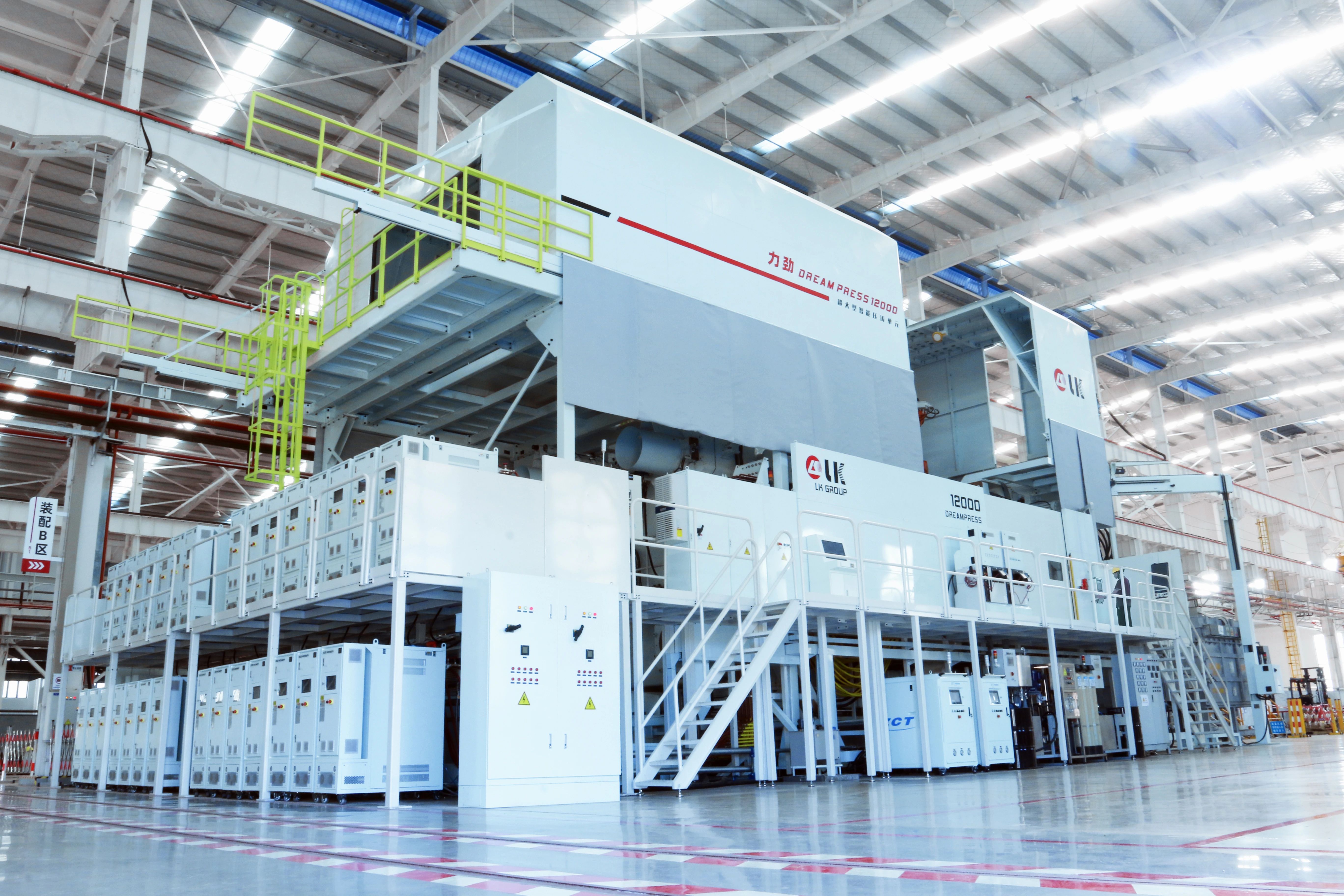
There was no further progress on integrated die-casting disclosed at Investor Day, but Lijin’s 12,000-ton die-casting machine has been assembled recently. The introduction of integrated die-casting can reduce 44% of the workstation area and improve 30% of the temporal and spatial efficiency.
“`And implementing a distributed final assembly-production form can reduce factory area by 40\% and manufacturing costs by 50\%.
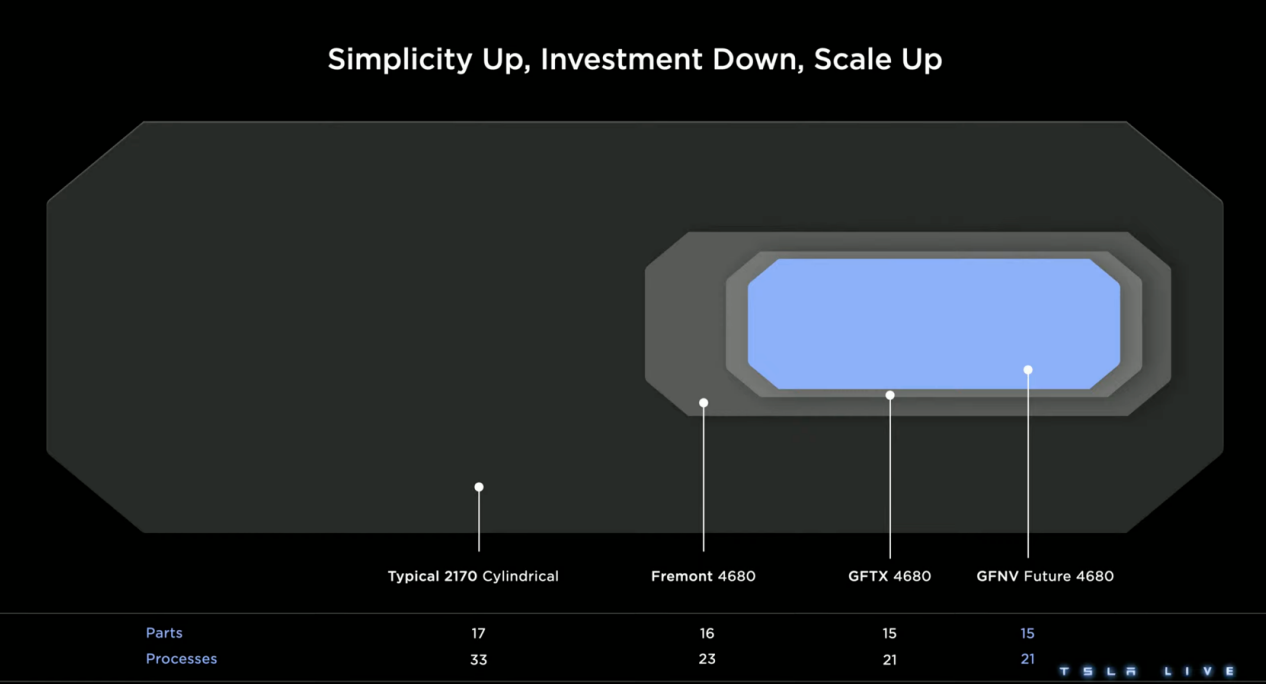
Regarding the 4680 battery, Tesla announced in January that it will build two factories in Nevada, USA to produce the Cybertruck and the 4680 battery. The 4680 battery parts produced by the Nevada and Texas battery factories have been greatly reduced compared to the 2170 with only 15 parts and 21 processes. Investors believe that if the 4680 battery can be manufactured on a large scale, it will directly reduce 6\% of the BOM cost.
The only “new technology” displayed on Investor Day was the heat pump. It can reduce more than 100 components, reduce 99\% of the manufacturing process, and achieve fully automated production with a production pace of 7 seconds per unit.

Sell an additional 30,000 “vehicles” in 2023
It is difficult to increase electric vehicle production capacity, but building more battery energy storage factories is a possibility.
Based on reserved clean energy such as wind and solar power, there is a broad market for energy storage businesses in North America where there are many companies, production enterprises, and households with energy storage needs due to underdeveloped local power grids.
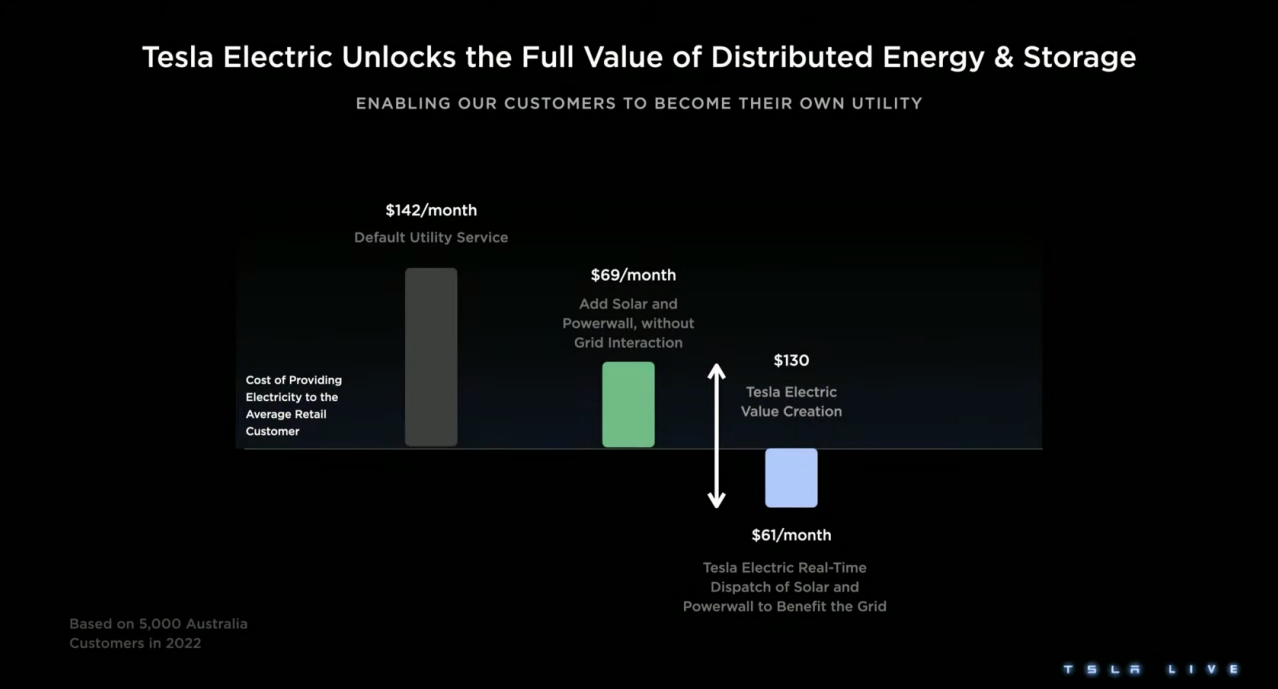
Compared to the traditional energy services which cost 142 US dollars/month in the financials displayed on Investor Day, Tesla’s clean energy services only cost 69 US dollars/month and can also earn 61 US dollars/month by selling electricity back to the grid, almost providing “free” electricity.
In 2022, Tesla’s energy storage business deployed 6.5GWh, achieving a gross profit of 288 million US dollars with a gross margin of 7\%. The gross margin of 1GWh is about 44.31 million US dollars.“`
Currently, Tesla has built a 40GWH battery energy storage factory and has set a target of 100GWH for energy storage projects in 2023, which means more than $4.4 billion in gross profit.
In 2022, Tesla’s gross profit for a single vehicle will be $155,000, and 100GWH means selling an additional 28,000 “vehicles”.
It is worth noting that Musk has previously stated that the gross profit margin for energy storage business is expected to reach around 20%, considering that the scaling of energy storage factories and production capacity will be much simpler than that of automobile factories, the only limitation to the future development of Tesla’s energy storage business is cell supply. Ningde times is reportedly one of Tesla’s main partners in the US energy storage business.
Coincidentally, on the same day as Tesla’s investor day, Ideal Automobile held its spring communication meeting. The former is building a grand plan from 10 to 100, while the latter is embarking on a journey from 1 to 10.
Li Xiang analyzed the ideal’s management and development concept from the perspective of energy revolution and information revolution represented by automatic driving, which is highly consistent with Tesla’s road in the past decade. It can be seen that Tesla’s foresight and landing capability as “pathfinder” are very strong.
Therefore, “Phase 3” should not be regarded as a simple marketing event. After completing the 1-10 architecture construction of vehicles, automatic driving, and energy storage, “Phase 3” is the beginning of Tesla’s systematic enrichment and acceleration. Over the past decade, Tesla has repeatedly proven that systematic capability is its greatest strength.
“`
This article is a translation by ChatGPT of a Chinese report from 42HOW. If you have any questions about it, please email bd@42how.com.
